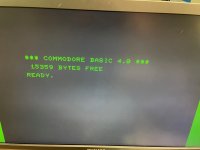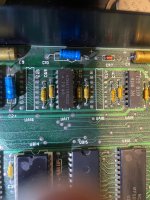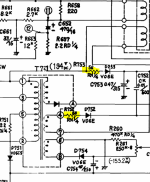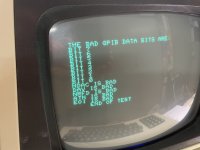Upcoming Events:
| VCF West | Aug 01 - 02 2025, | CHM, Mountain View, CA |
| VCF Midwest | Sep 13 - 14 2025, | Schaumburg, IL |
| VCF Montreal | Jan 24 - 25, 2026, | RMC Saint Jean, Montreal, Canada |
| VCF SoCal | Feb 14 - 15, 2026, | Hotel Fera, Orange CA |
| VCF Southwest | May 29 - 31, 2026, | Westin Dallas Fort Worth Airport |
| VCF Southeast | June, 2026 | Atlanta, GA |
-
Please review our updated Terms and Rules here
You are using an out of date browser. It may not display this or other websites correctly.
You should upgrade or use an alternative browser.
You should upgrade or use an alternative browser.
Commodore 3016 scrambled screen
- Thread starter TheMatrix
- Start date
TheMatrix
Experienced Member
piggy-back did the trickThe "piggy-back" test involves very carefully "piggy-backing" a known, good, working DRAM on top of a DRAM under test (with the power OFF). Make sure that all of the pins mate correctly without shorting out.
Power ON and test.
Power OFF before changing the DRAM location.
If you get a scenario that now works, power OFF and remove the piggy-back chip. Test again to make sure it FAILS and then place the piggy-back chip on again and re-test to make sure it PASSES again. If this is so, replace the associated DRAM.
If you piggy-back test all eight (8) devices and have not observed a working machine at the end, either the piggy-back test method is not working for you OR you have more than one (1) faulty DRAM.
Always, always, power OFF before adding or removing the piggy-back chip.
Dave
I found that UA17 was defect. Replaced it and now it's working.
daver2
10k Member
Nice.
UA17? That is not a DRAM is it?
Dave
UA17? That is not a DRAM is it?
Dave
TheMatrix
Experienced Member
daver2
10k Member
Ah, looking at the wrong schematic!
The piggy-back method only works under certain circumstances - but it can be worth trying it before de-soldering a part just to see if it fixes the problem (as in your case).
Dave
The piggy-back method only works under certain circumstances - but it can be worth trying it before de-soldering a part just to see if it fixes the problem (as in your case).
Dave
TheMatrix
Experienced Member
Now i need to focus on the monitor.
There is no contrast at all.
There is no contrast at all.
daver2
10k Member
First thing is to be careful!
The second thing is to measure all of the DC voltages (up to 200V or so) using a multimeter. Obtain the schematic and PCB layout for your particular monitor.
Ask if you don't know the best way of doing this without killing yourself ...
...
Dave
The second thing is to measure all of the DC voltages (up to 200V or so) using a multimeter. Obtain the schematic and PCB layout for your particular monitor.
Ask if you don't know the best way of doing this without killing yourself
Dave
TheMatrix
Experienced Member
I know  I have worked at a repair department for Television back in the nineties. Repaires a lot of TV's.
I have worked at a repair department for Television back in the nineties. Repaires a lot of TV's.
daver2
10k Member
You are still alive, so you must know what you are doing then...
There are a few people that I know who I would have grave concerns over, quite literally!
Always good to ask ...
...
Dave
There are a few people that I know who I would have grave concerns over, quite literally!
Always good to ask
Dave
Hugo Holden
Veteran Member
Don't worry about the charge stored in the CRT bulb, it won't kill you only give you a fright.
Its is not about the high voltage, its is about the stored energy. In a crt that is off, the CRT', depending on size, can store from 10mJ to 1J, the latter being the massively large color CRT screens.
A typical 9" monochrome VDU it is about 30mJ which is about the same energy as a single zap from a lawnmower or car spark plug. These don't kill people.
A farmer's electric fence , that can dump about 3 to 10J into a cow or human, and that is extremely unpleasant, but doesn't kill people or cattle very often. I once received a 10J shock on a farm also while standing on wet ground, the shock was very nasty (brutal) and much more potent than anything a charged CRT can deliver.
A charged CRT dissipates the bulb charge in a day because the silicon EHT rectifiers have non zero reverse leakage and color sets often have a bleeder resistance which discharges the CRT bulb capacitance in less than 10 minutes. Zaps from stored charges in CRT, after the VDU is de-powered, give people a fright, that is all, but it can make them drop the CRT if they are carrying it, or perhaps gash their hand on a sharp metal object when they rapidly withdraw it after a zap.
I was carrying one once, got a zap from the anode connection, but I knew it was harmless and therefore maintained my composure I didn't drop it.
But the you-tubers who think they know better post all sorts of nonsense showing sparks when they go to short out charged CRT's making out it is fearsome danger, but like I say, little different than those from your lawnmower spark plug or car, in terms of the delivered energy for a single discharge and a fraction of the typical Farmer's electric fence. And there is all sorts of rubbish on the internet about having to discharge CRT's before you work on VDU's. Complete nonsense. If you don't go under the rubber anode cap (which is not required for most repairs) you cannot come in contact with the charge, it stays trapped in the tube, it cannot exit its base pins. And if you wait a day with the set turned off, the charge has dissipated anyway.
I have no concerns at all about CRT bulb charges and merely regard these in a similar manner to other sources for one off electrostatic shocks and discharges and have been working on CRT gear for over 50 years, but....... there is danger:
Inside a VDU or TV, especially one that is powered, the dangerous part is when it is running. There are line power voltages inside it (115 or 230V) and there are B+ supplies of up to 400V in some cases. And there are often voltages in the order of > 100V on the CRT's neck board. Many of these supplies can deliver over 30mA continuous current and exceed the high danger zone for cardiac arrest or arrythmias.
So when the VDU Is powered be very mindful of the dangerous voltages, much as you should if you were working on a vintage tube based radio or guitar amplifier. Also be aware that the main filter caps in the SMPS in a VDU or TV can store their voltage and charge for some time after turn-off and these large capacitances (unlike those of a CRT bulb) can definitely store enough energy to kill a person. For example, a 470uF capacitor charged to 320V stores 24J of energy, not only is that nasty and likely throw you off your chair, it is risky. Be careful, especially if the TV is powered, or immediately after you switch it off because of the charge in the SMPS's capacitances, and even when it is off, you still often have line power entering the set and headed to one side of the on-off switch which might have exposed connections. Leave the set off for at least an hour before poking around for passive tests, this makes sure the SMPS caps are discharged. All of these concerns of course apply to pretty well to any line powered appliance, not just VDU's.
Its is not about the high voltage, its is about the stored energy. In a crt that is off, the CRT', depending on size, can store from 10mJ to 1J, the latter being the massively large color CRT screens.
A typical 9" monochrome VDU it is about 30mJ which is about the same energy as a single zap from a lawnmower or car spark plug. These don't kill people.
A farmer's electric fence , that can dump about 3 to 10J into a cow or human, and that is extremely unpleasant, but doesn't kill people or cattle very often. I once received a 10J shock on a farm also while standing on wet ground, the shock was very nasty (brutal) and much more potent than anything a charged CRT can deliver.
A charged CRT dissipates the bulb charge in a day because the silicon EHT rectifiers have non zero reverse leakage and color sets often have a bleeder resistance which discharges the CRT bulb capacitance in less than 10 minutes. Zaps from stored charges in CRT, after the VDU is de-powered, give people a fright, that is all, but it can make them drop the CRT if they are carrying it, or perhaps gash their hand on a sharp metal object when they rapidly withdraw it after a zap.
I was carrying one once, got a zap from the anode connection, but I knew it was harmless and therefore maintained my composure I didn't drop it.
But the you-tubers who think they know better post all sorts of nonsense showing sparks when they go to short out charged CRT's making out it is fearsome danger, but like I say, little different than those from your lawnmower spark plug or car, in terms of the delivered energy for a single discharge and a fraction of the typical Farmer's electric fence. And there is all sorts of rubbish on the internet about having to discharge CRT's before you work on VDU's. Complete nonsense. If you don't go under the rubber anode cap (which is not required for most repairs) you cannot come in contact with the charge, it stays trapped in the tube, it cannot exit its base pins. And if you wait a day with the set turned off, the charge has dissipated anyway.
I have no concerns at all about CRT bulb charges and merely regard these in a similar manner to other sources for one off electrostatic shocks and discharges and have been working on CRT gear for over 50 years, but....... there is danger:
Inside a VDU or TV, especially one that is powered, the dangerous part is when it is running. There are line power voltages inside it (115 or 230V) and there are B+ supplies of up to 400V in some cases. And there are often voltages in the order of > 100V on the CRT's neck board. Many of these supplies can deliver over 30mA continuous current and exceed the high danger zone for cardiac arrest or arrythmias.
So when the VDU Is powered be very mindful of the dangerous voltages, much as you should if you were working on a vintage tube based radio or guitar amplifier. Also be aware that the main filter caps in the SMPS in a VDU or TV can store their voltage and charge for some time after turn-off and these large capacitances (unlike those of a CRT bulb) can definitely store enough energy to kill a person. For example, a 470uF capacitor charged to 320V stores 24J of energy, not only is that nasty and likely throw you off your chair, it is risky. Be careful, especially if the TV is powered, or immediately after you switch it off because of the charge in the SMPS's capacitances, and even when it is off, you still often have line power entering the set and headed to one side of the on-off switch which might have exposed connections. Leave the set off for at least an hour before poking around for passive tests, this makes sure the SMPS caps are discharged. All of these concerns of course apply to pretty well to any line powered appliance, not just VDU's.
TheMatrix
Experienced Member
daver2
10k Member
Ah, the classic monitor faults.
Dave
Dave
TheMatrix
Experienced Member
Do you also know how the check if the 6520 is working ok?
IEEE488 port is not working.
IEEE488 port is not working.
daver2
10k Member
There is a test program in the book "PET and the IEEE 488 Bus (GPIB)" by Eugene Fisher and C.W.Jensen.
Page 184.
This book is available online as a PDF.
If this program detects a failure, we can look at whether it is the 6520 or one of the IEEE 488 buffers.
Dave
Page 184.
This book is available online as a PDF.
If this program detects a failure, we can look at whether it is the 6520 or one of the IEEE 488 buffers.
Dave
TheMatrix
Experienced Member
Well, you mentioned the title, and now i know i have the real book. 
daver2
10k Member
There we go!
I have the real book as well, although it is getting a bit tatty now with use...
Dave
I have the real book as well, although it is getting a bit tatty now with use...
Dave
TheMatrix
Experienced Member
daver2
10k Member
You are probably right (gut feeling) but worth checking the 'failed' bits against the schematic to see if they are all sourced from the same 6520.
There are some IEEE488 signals sourced from the VIA (I think). These other control signals should be OK and not mentioned in the list of faulty signals.
I would always do this manual check. Sometimes you have a load of faulty buffers and not a duff 6520!
You can also POKE values to the 6520 and see the result on a logic probe to really see if it is the 6520 that is dead. This is relatively simple, and is described in the book.
Ask if it doesn't make sense, and I can guide you through the process.
Dave
There are some IEEE488 signals sourced from the VIA (I think). These other control signals should be OK and not mentioned in the list of faulty signals.
I would always do this manual check. Sometimes you have a load of faulty buffers and not a duff 6520!
You can also POKE values to the 6520 and see the result on a logic probe to really see if it is the 6520 that is dead. This is relatively simple, and is described in the book.
Ask if it doesn't make sense, and I can guide you through the process.
Dave
TheMatrix
Experienced Member
daver2
10k Member
Chapter 2 page 28 to the end of the chapter (page 35).
Dave
Dave




